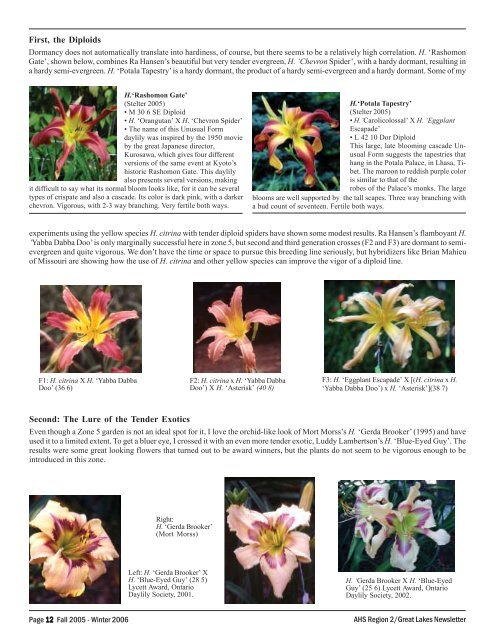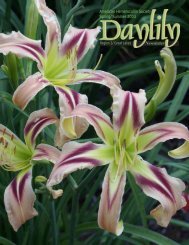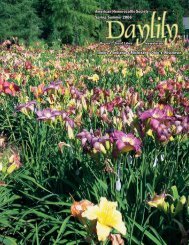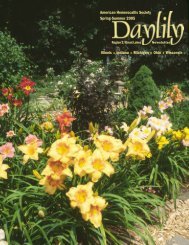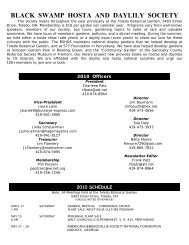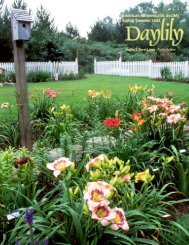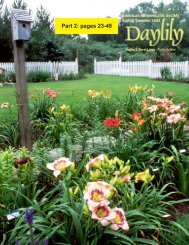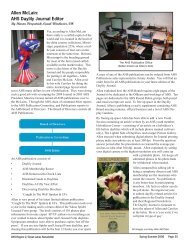Pages - AHS Region 2
Pages - AHS Region 2
Pages - AHS Region 2
You also want an ePaper? Increase the reach of your titles
YUMPU automatically turns print PDFs into web optimized ePapers that Google loves.
First, the Diploids<br />
Dormancy does not automatically translate into hardiness, of course, but there seems to be a relatively high correlation. H. ‘Rashomon<br />
Gate’, shown below, combines Ra Hansen’s beautiful but very tender evergreen, H. ‘Chevron Spider’, with a hardy dormant, resulting in<br />
a hardy semi-evergreen. H. ‘Potala Tapestry’ is a hardy dormant, the product of a hardy semi-evergreen and a hardy dormant. Some of my<br />
H.‘Rashomon Gate’<br />
(Stelter 2005)<br />
• M 30 6 SE Diploid<br />
• H. ‘Orangutan’ X H. ‘Chevron Spider’<br />
• The name of this Unusual Form<br />
daylily was inspired by the 1950 movie<br />
by the great Japanese director,<br />
Kurosawa, which gives four different<br />
versions of the same event at Kyoto’s<br />
historic Rashomon Gate. This daylily<br />
also presents several versions, making<br />
it difficult to say what its normal bloom looks like, for it can be several<br />
types of crispate and also a cascade. Its color is dark pink, with a darker<br />
chevron. Vigorous, with 2-3 way branching. Very fertile both ways.<br />
H.‘Potala Tapestry’<br />
(Stelter 2005)<br />
• H.‘Carolicolossal’ X H. ‘Eggplant<br />
Escapade’<br />
• L 42 10 Dor Diploid<br />
This large, late blooming cascade Unusual<br />
Form suggests the tapestries that<br />
hang in the Potala Palace, in Lhasa, Tibet.<br />
The maroon to reddish purple color<br />
is similar to that of the<br />
robes of the Palace’s monks. The large<br />
blooms are well supported by the tall scapes. Three way branching with<br />
a bud count of seventeen. Fertile both ways.<br />
experiments using the yellow species H. citrina with tender diploid spiders have shown some modest results. Ra Hansen’s flamboyant H.<br />
‘Yabba Dabba Doo’ is only marginally successful here in zone 5, but second and third generation crosses (F2 and F3) are dormant to semievergreen<br />
and quite vigorous. We don’t have the time or space to pursue this breeding line seriously, but hybridizers like Brian Mahieu<br />
of Missouri are showing how the use of H. citrina and other yellow species can improve the vigor of a diploid line.<br />
F1: H. citrina X H. ‘Yabba Dabba<br />
Doo’ (36 6)<br />
F2: H. citrina x H. ‘Yabba Dabba<br />
Doo’) X H. ‘Asterisk’ (40 8)<br />
F3: H. ‘Eggplant Escapade’ X [(H. citrina x H.<br />
‘Yabba Dabba Doo’) x H. ‘Asterisk’](38 7)<br />
Second: The Lure of the Tender Exotics<br />
Even though a Zone 5 garden is not an ideal spot for it, I love the orchid-like look of Mort Morss’s H. ‘Gerda Brooker’ (1995) and have<br />
used it to a limited extent. To get a bluer eye, I crossed it with an even more tender exotic, Luddy Lambertson’s H. ‘Blue-Eyed Guy’. The<br />
results were some great looking flowers that turned out to be award winners, but the plants do not seem to be vigorous enough to be<br />
introduced in this zone.<br />
Right:<br />
H. ‘Gerda Brooker’<br />
(Mort Morss)<br />
Left: H. ‘Gerda Brooker’ X<br />
H. ‘Blue-Eyed Guy’ (28 5)<br />
Lycett Award, Ontario<br />
Daylily Society, 2001.<br />
H. ‘Gerda Brooker X H. ‘Blue-Eyed<br />
Guy’ (25 6) Lycett Award, Ontario<br />
Daylily Society, 2002.<br />
Page 12 Fall 2005 - Winter 2006 <strong>AHS</strong> <strong>Region</strong> 2/Great Lakes Newsletter


